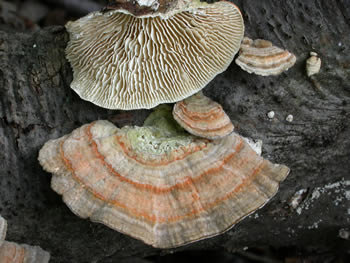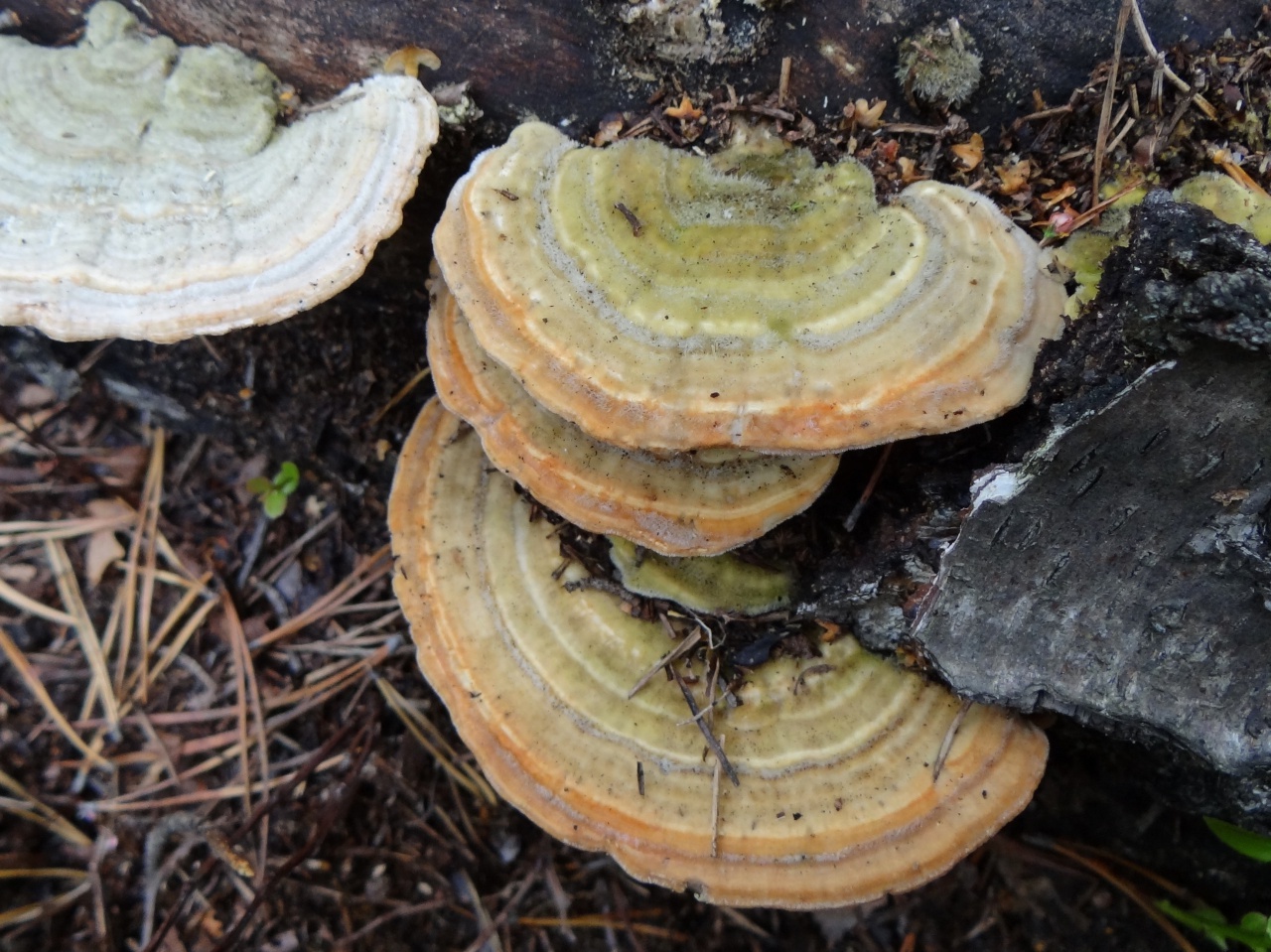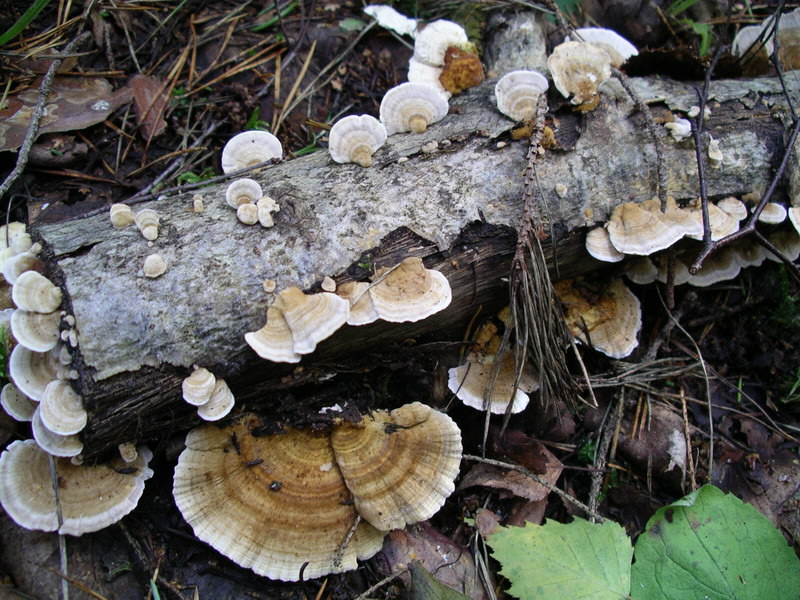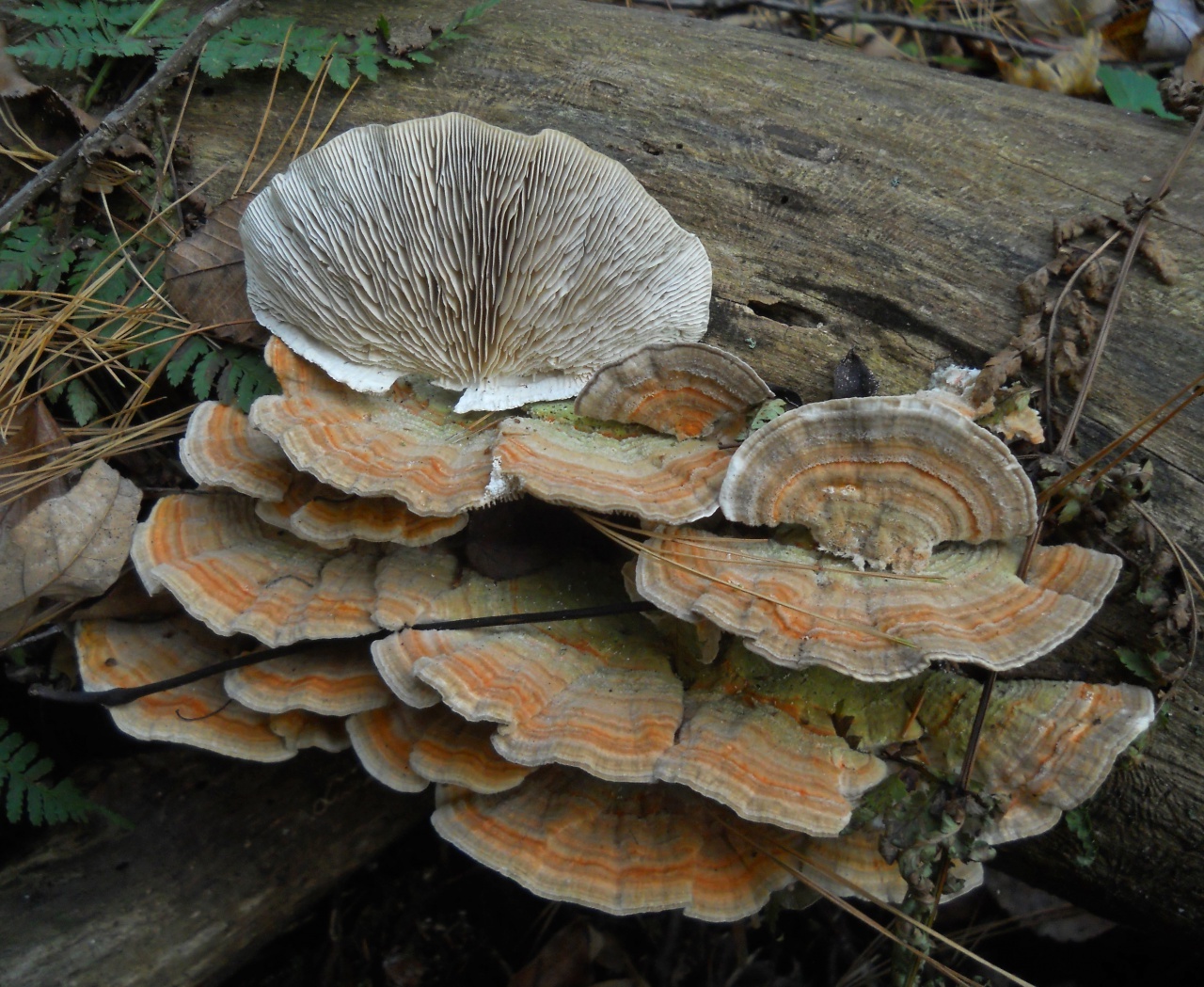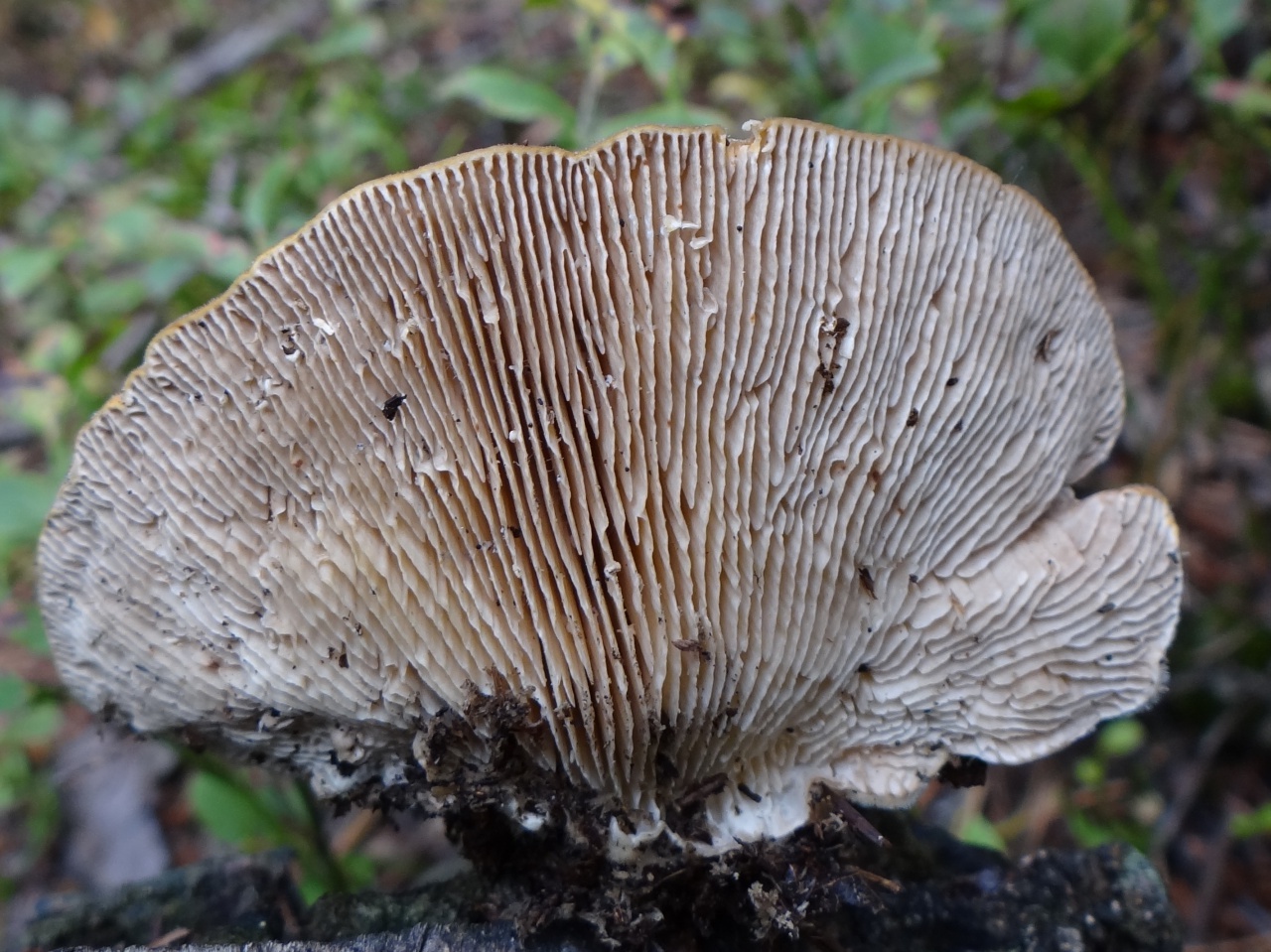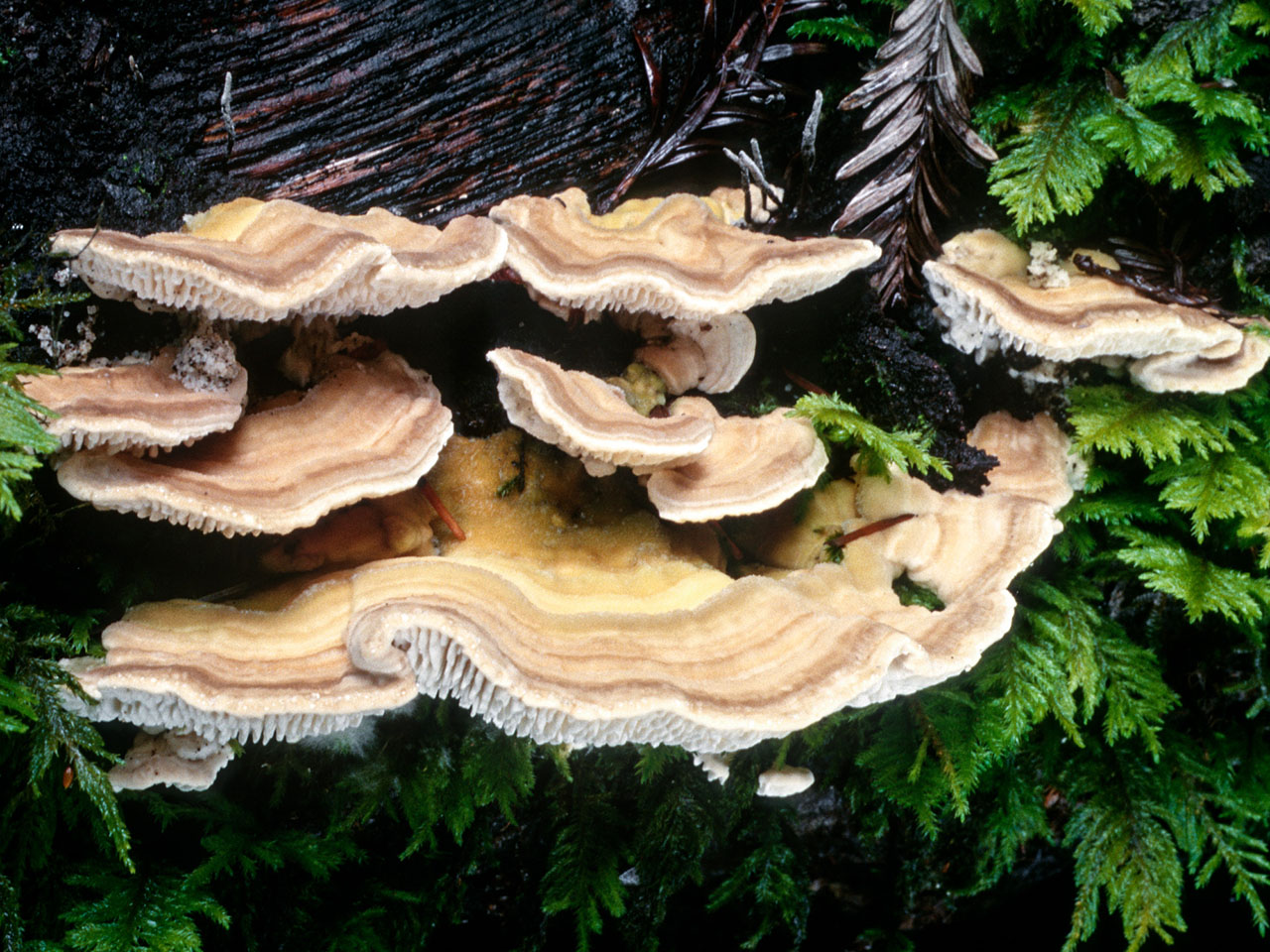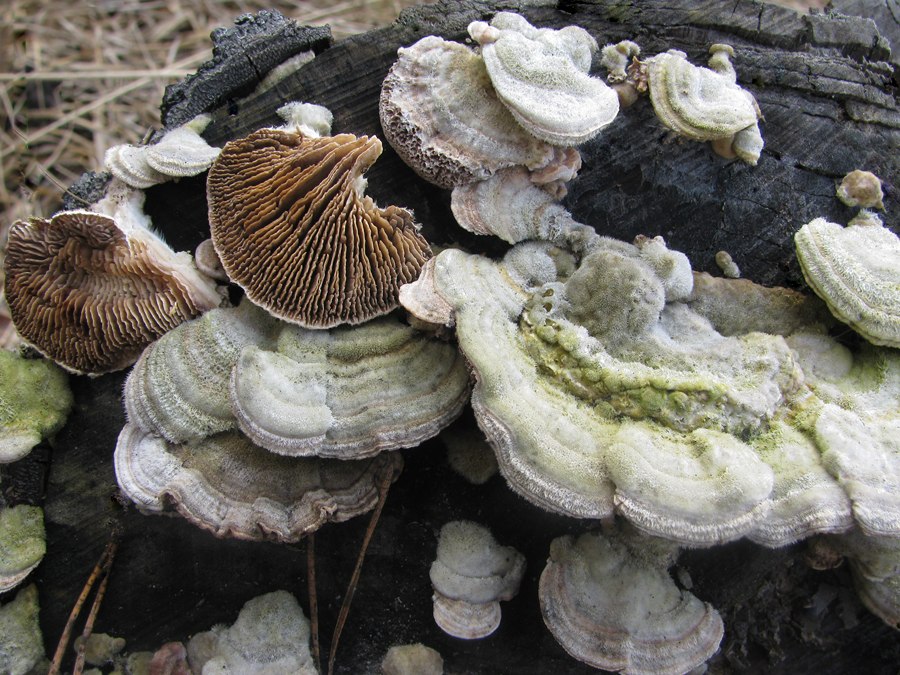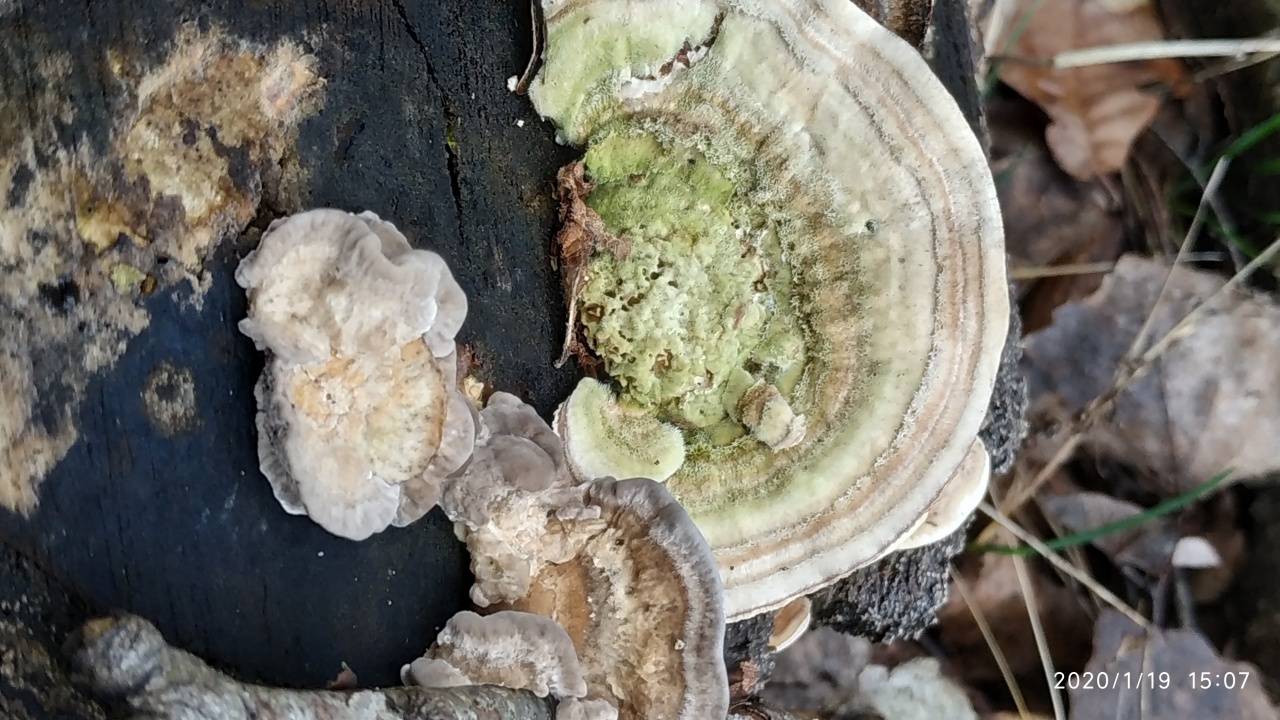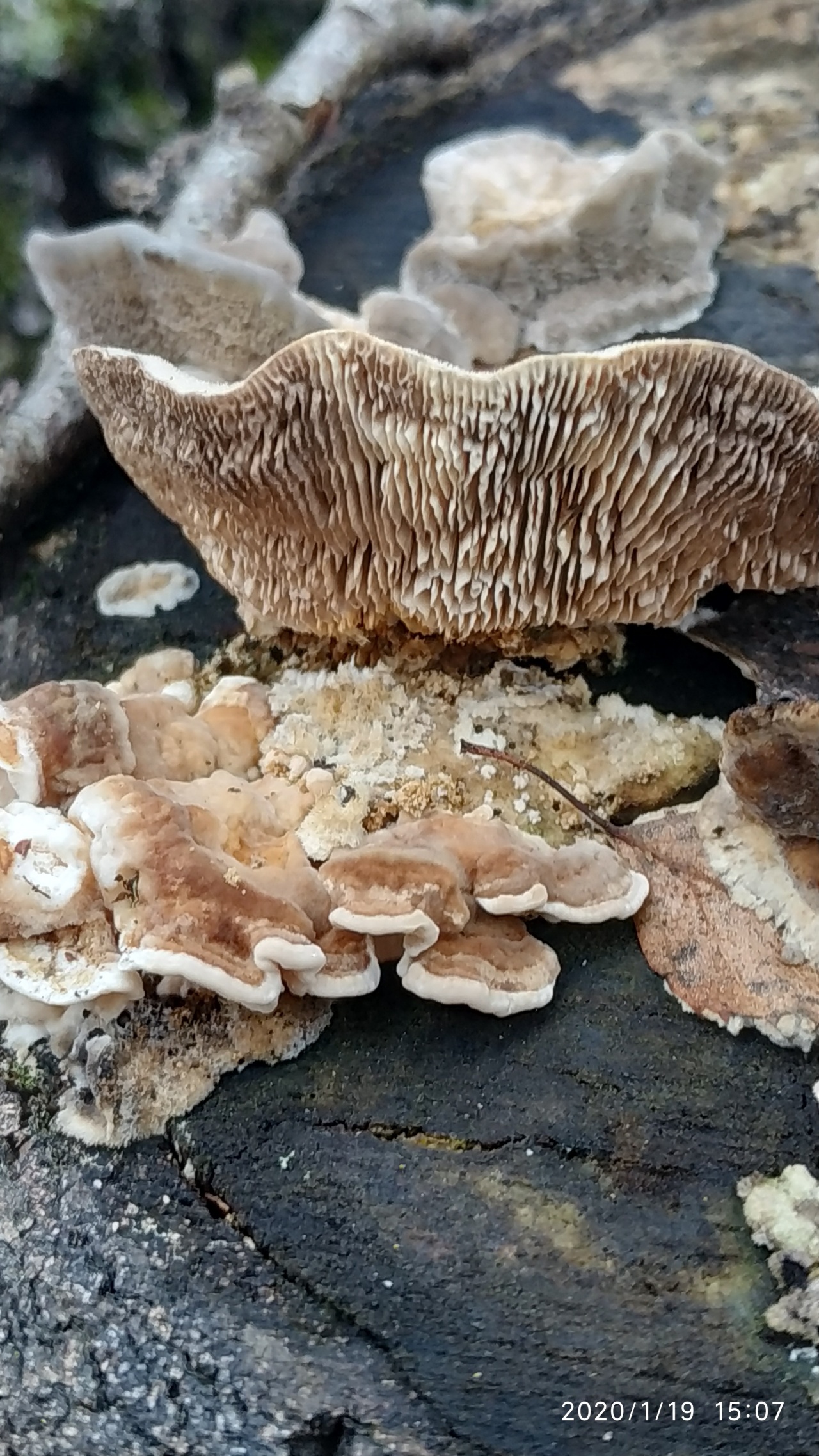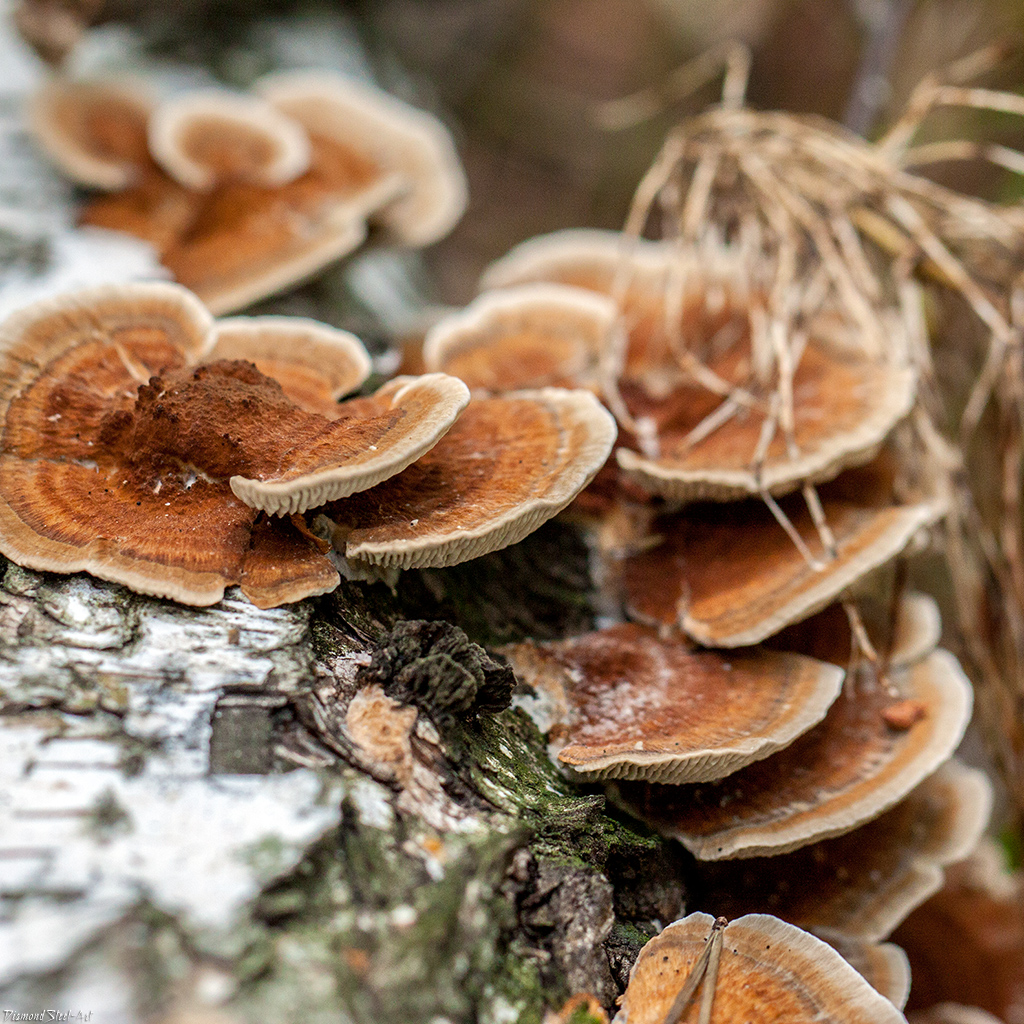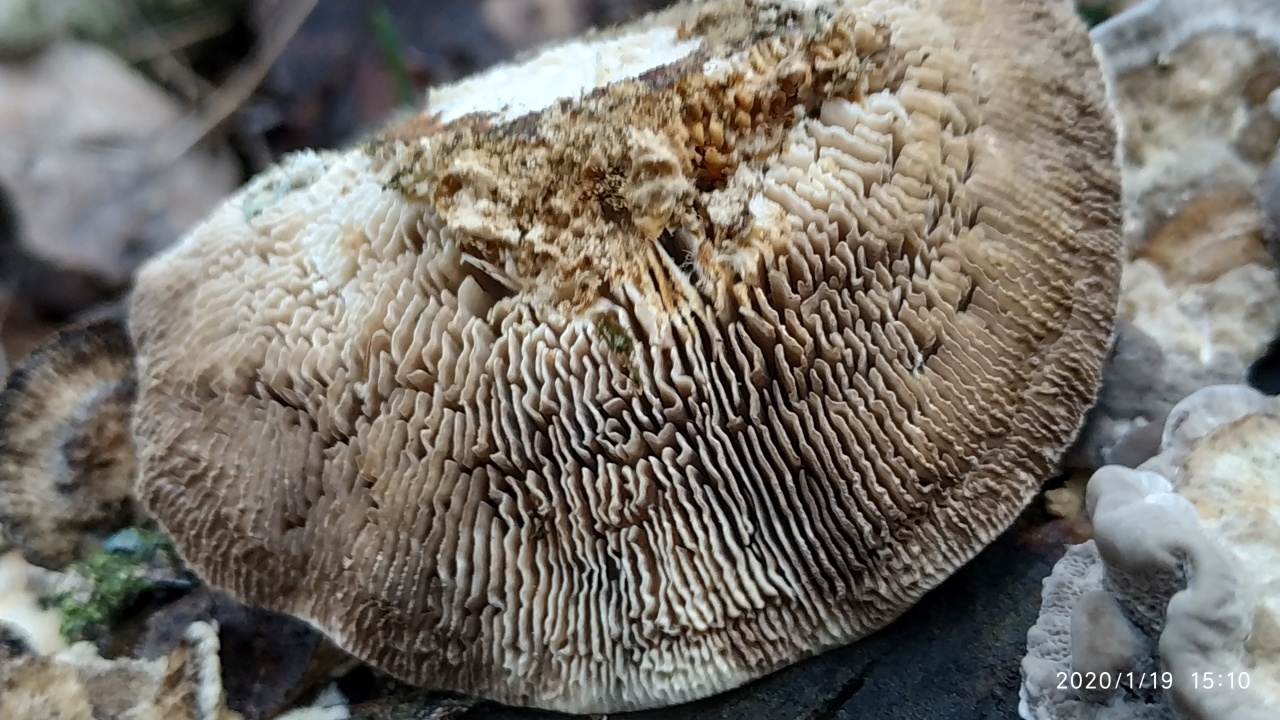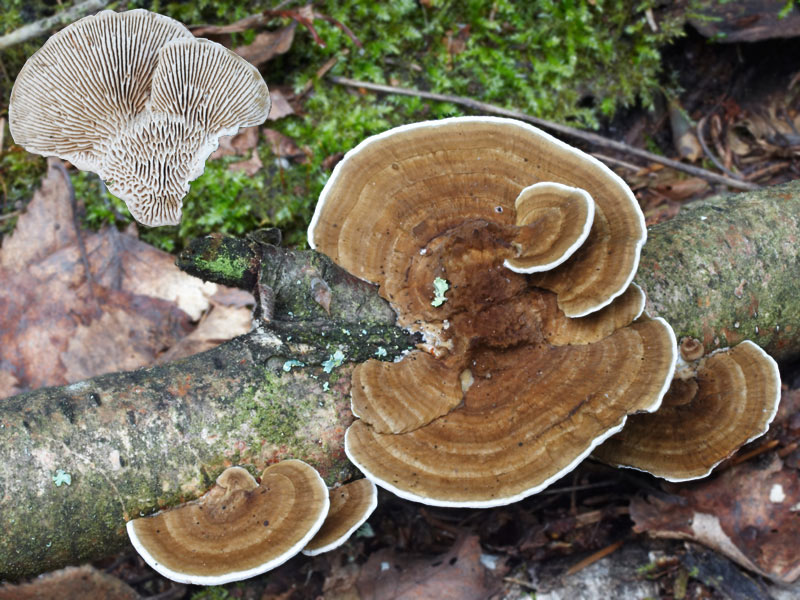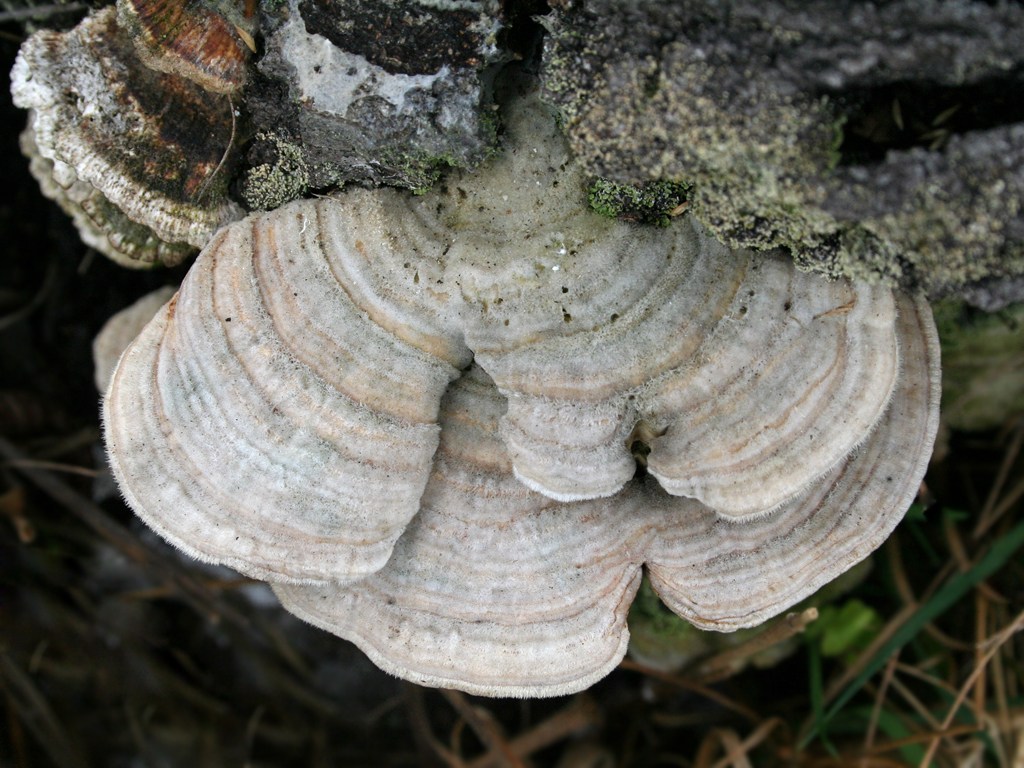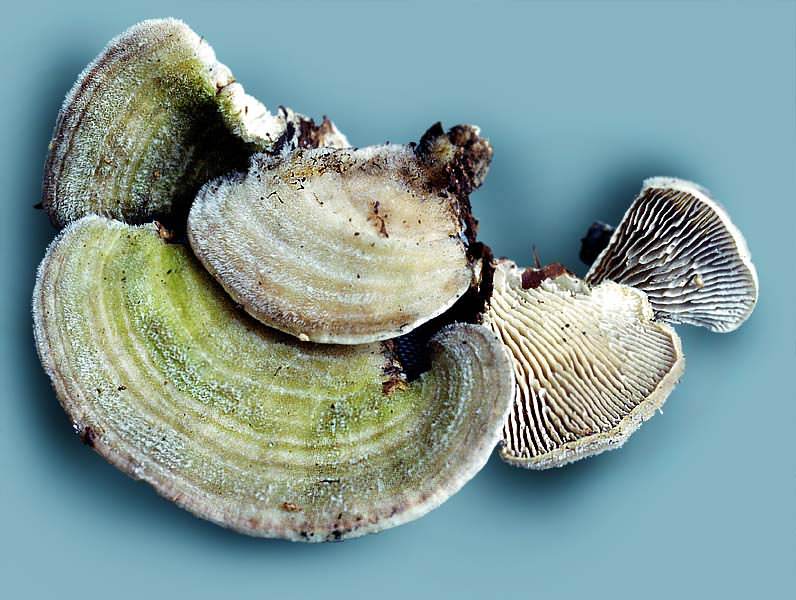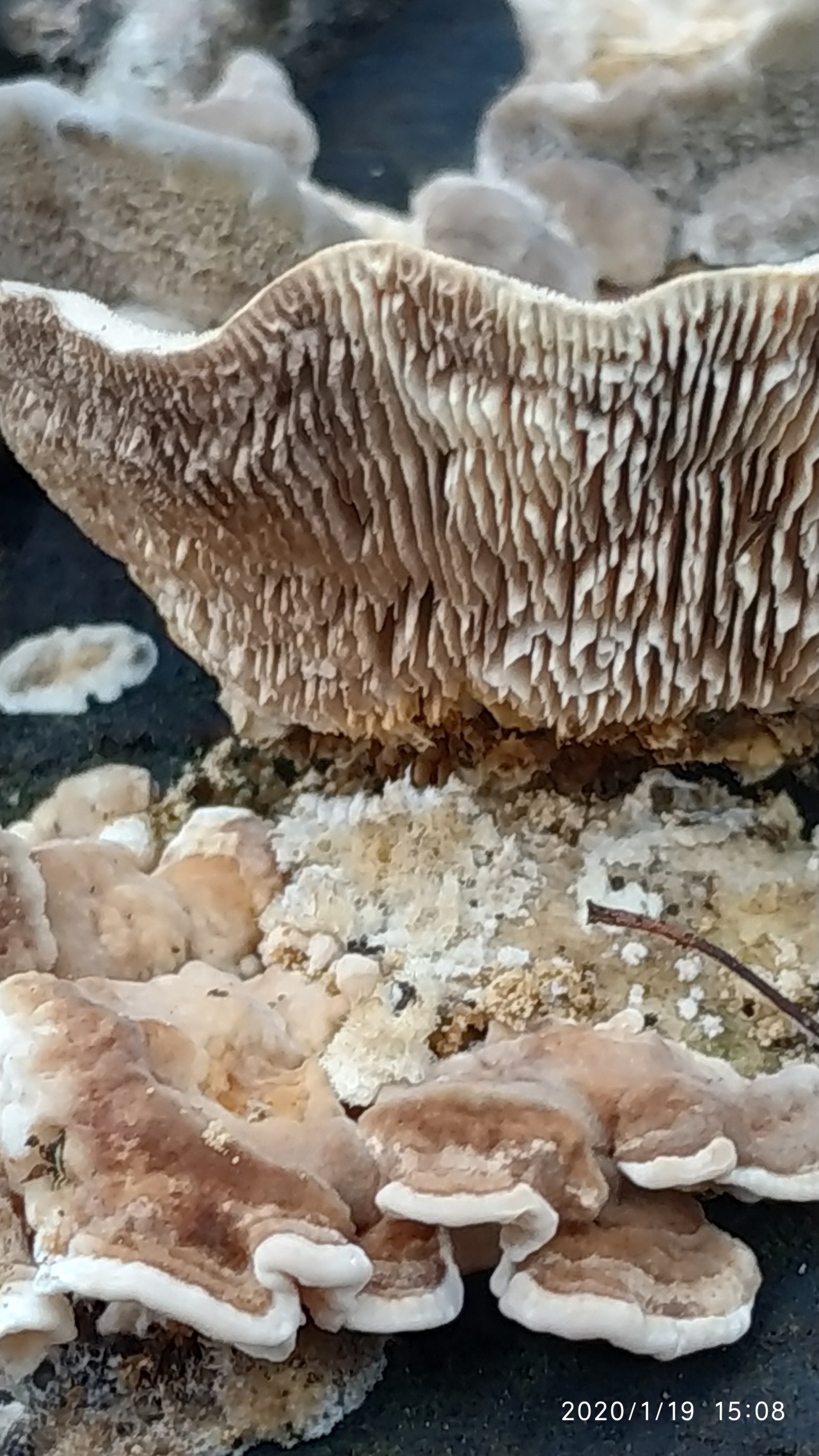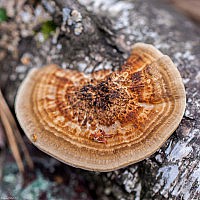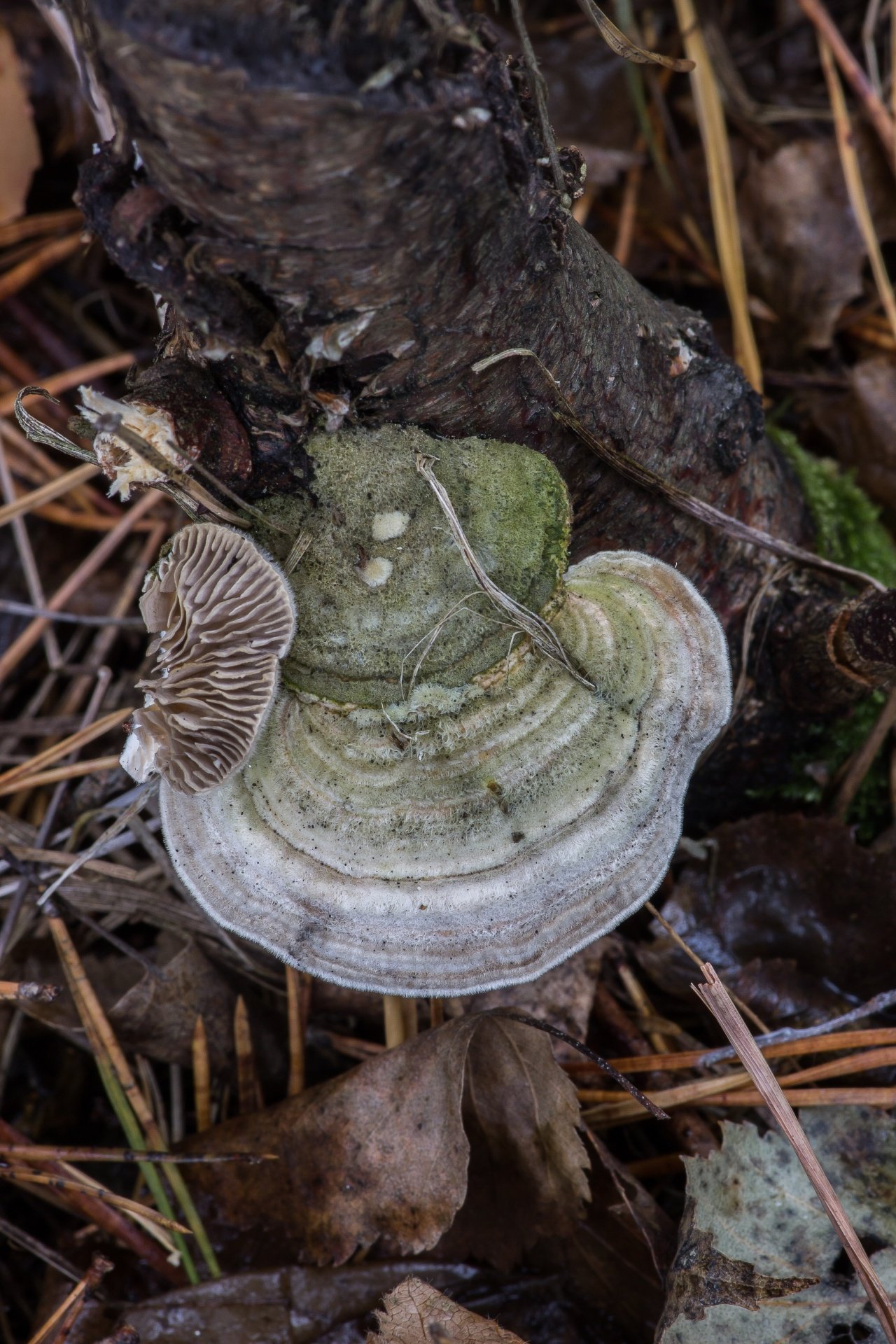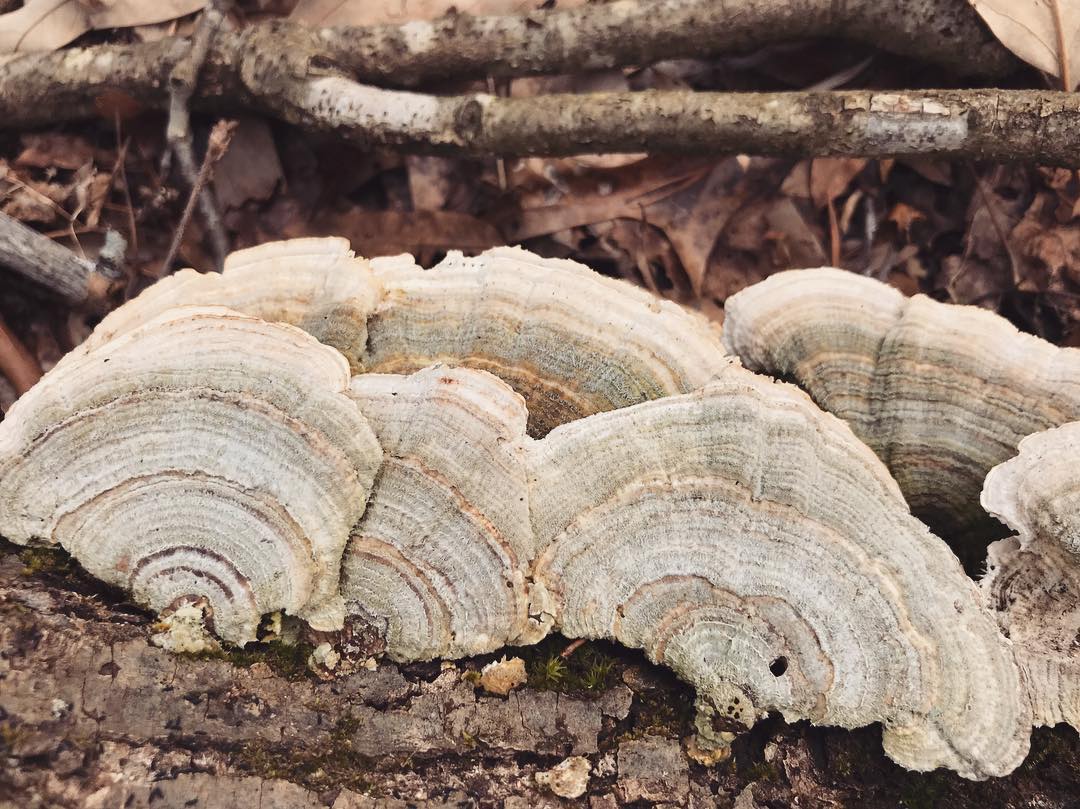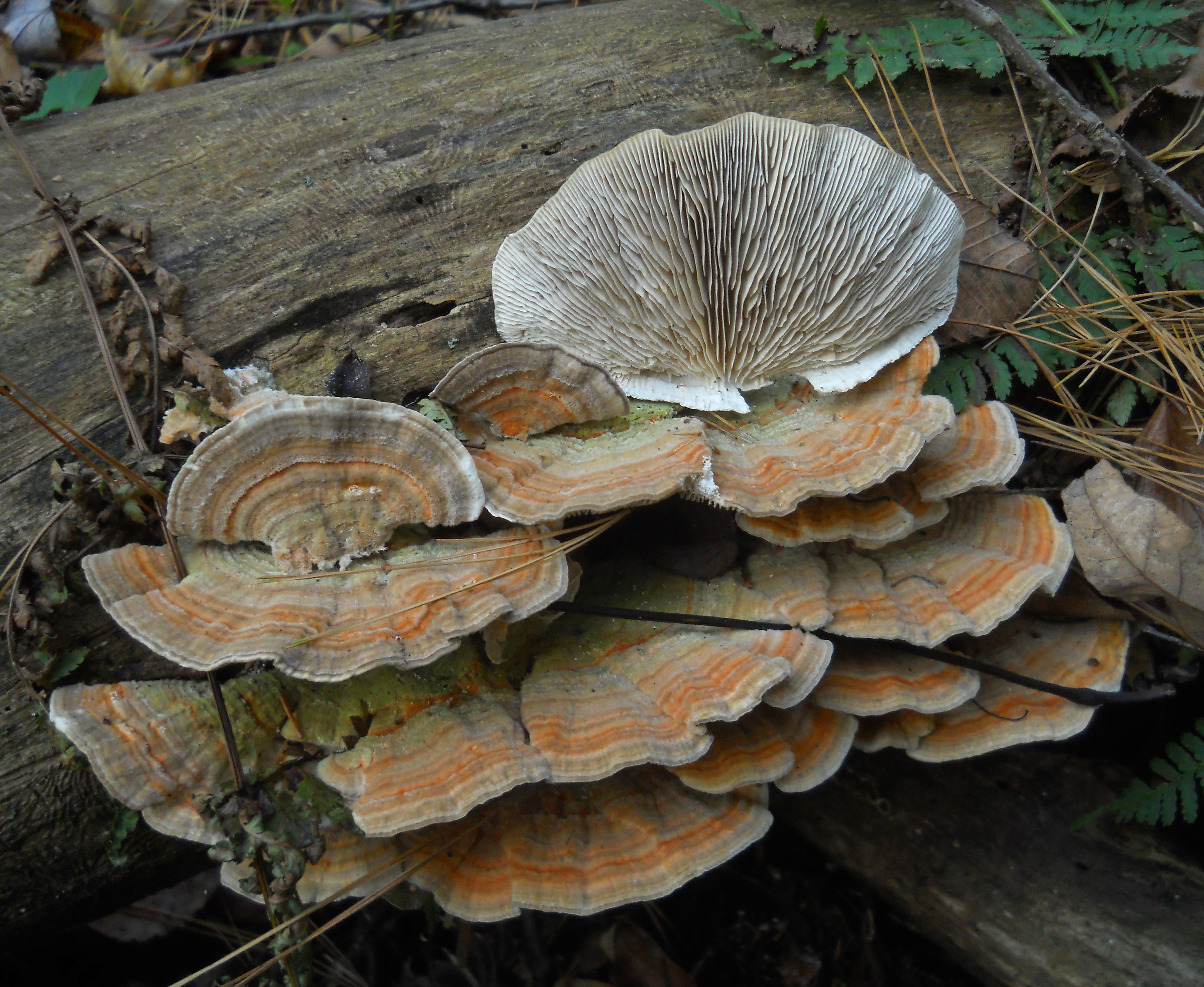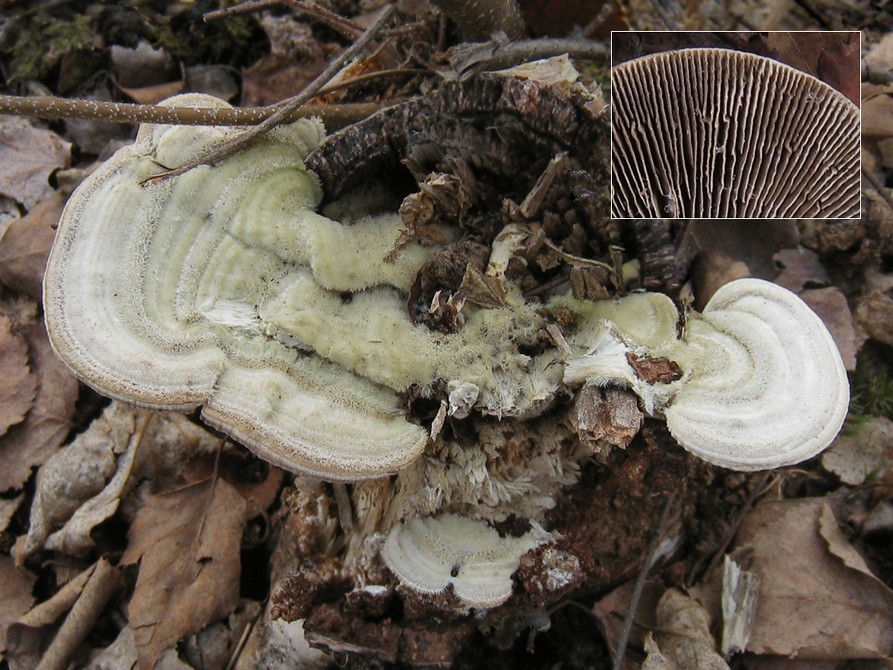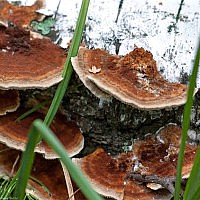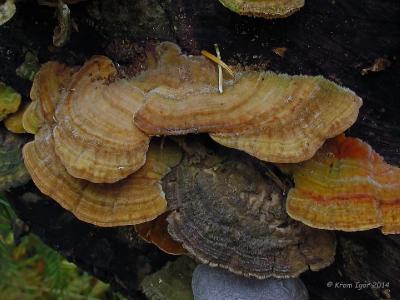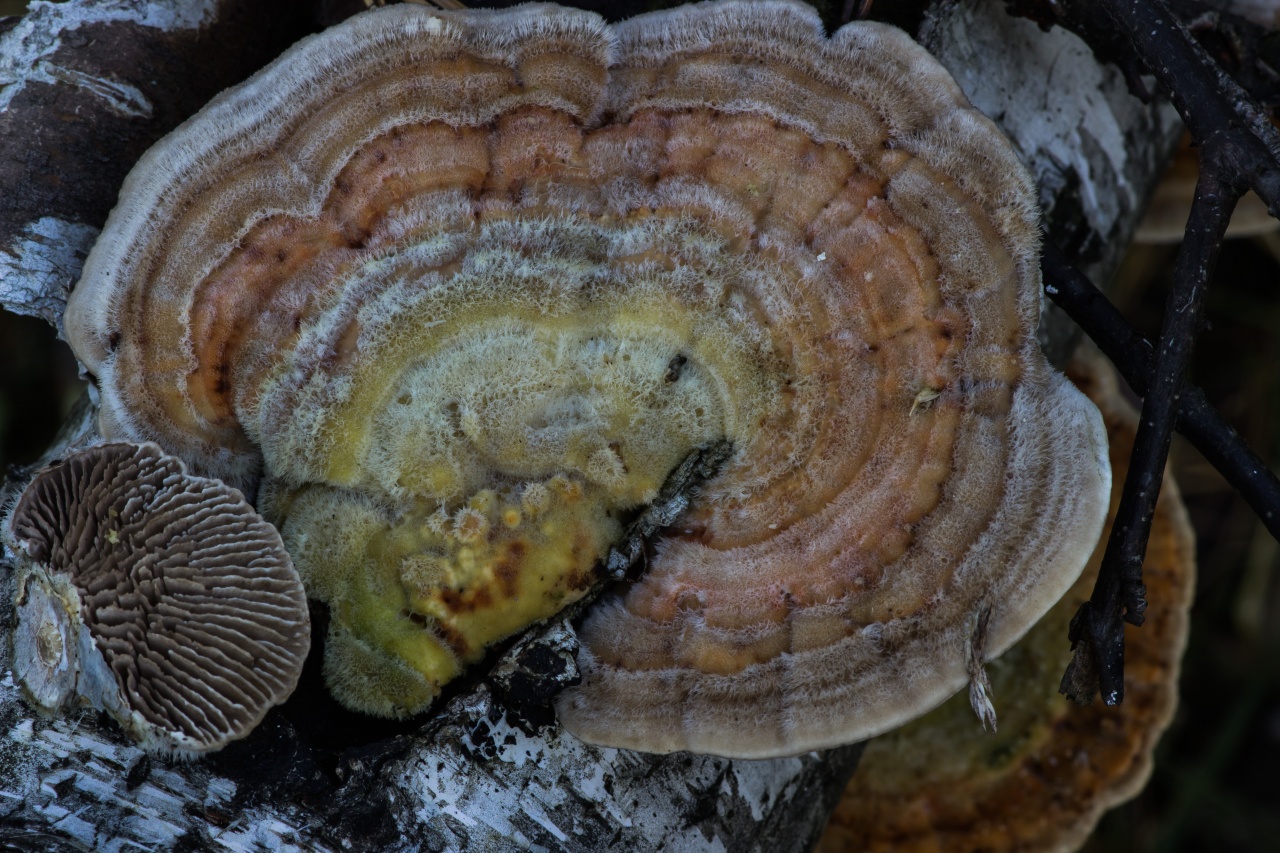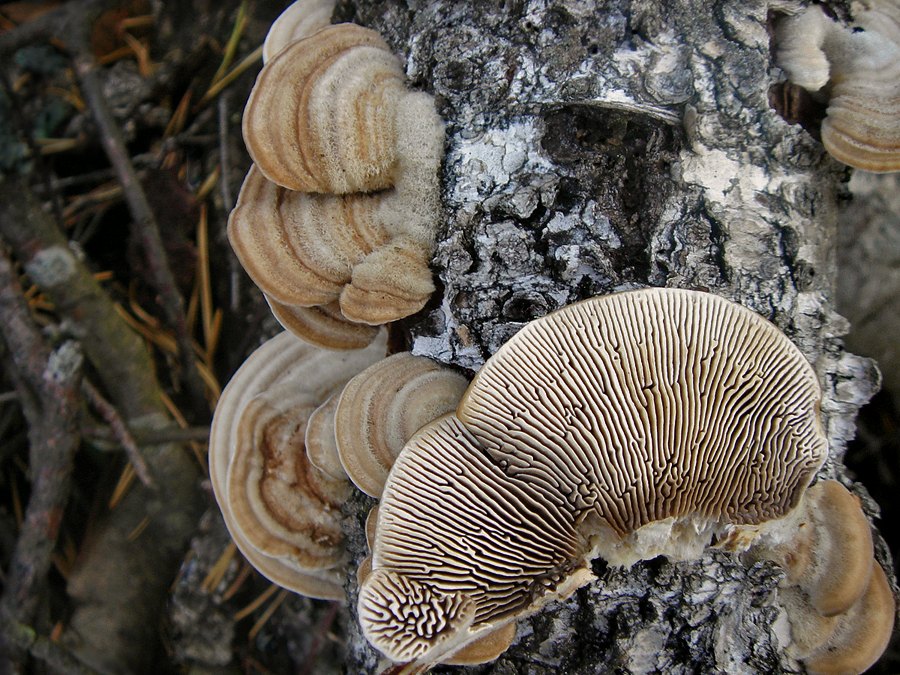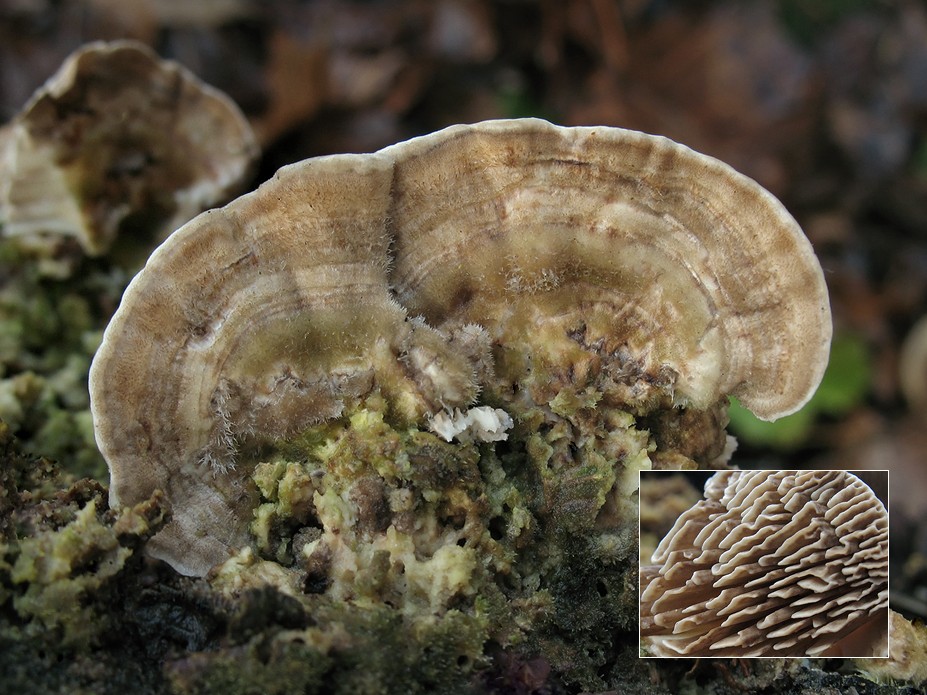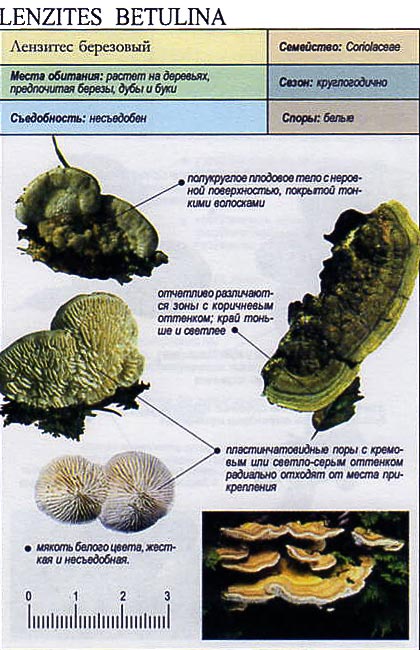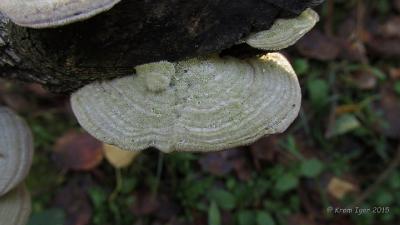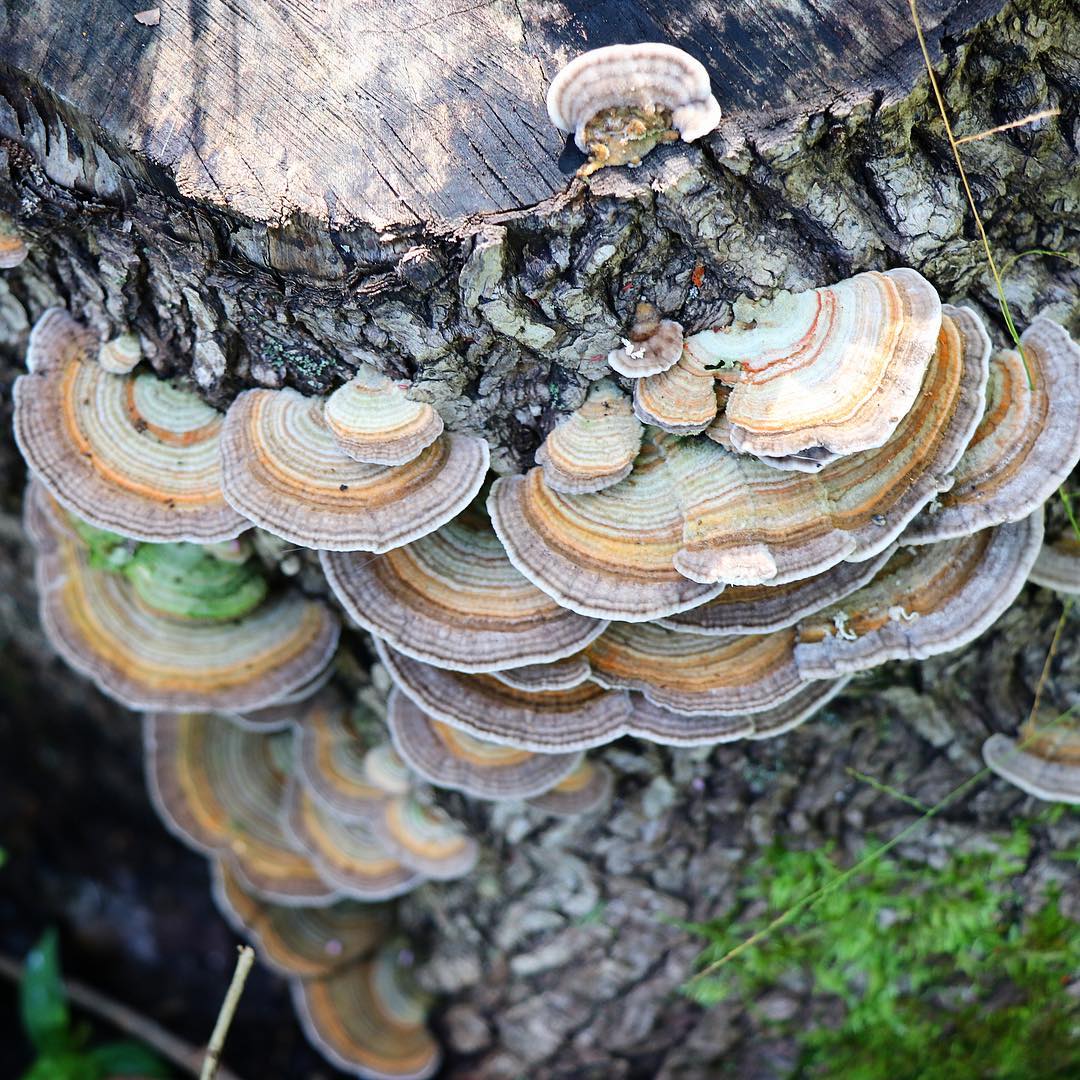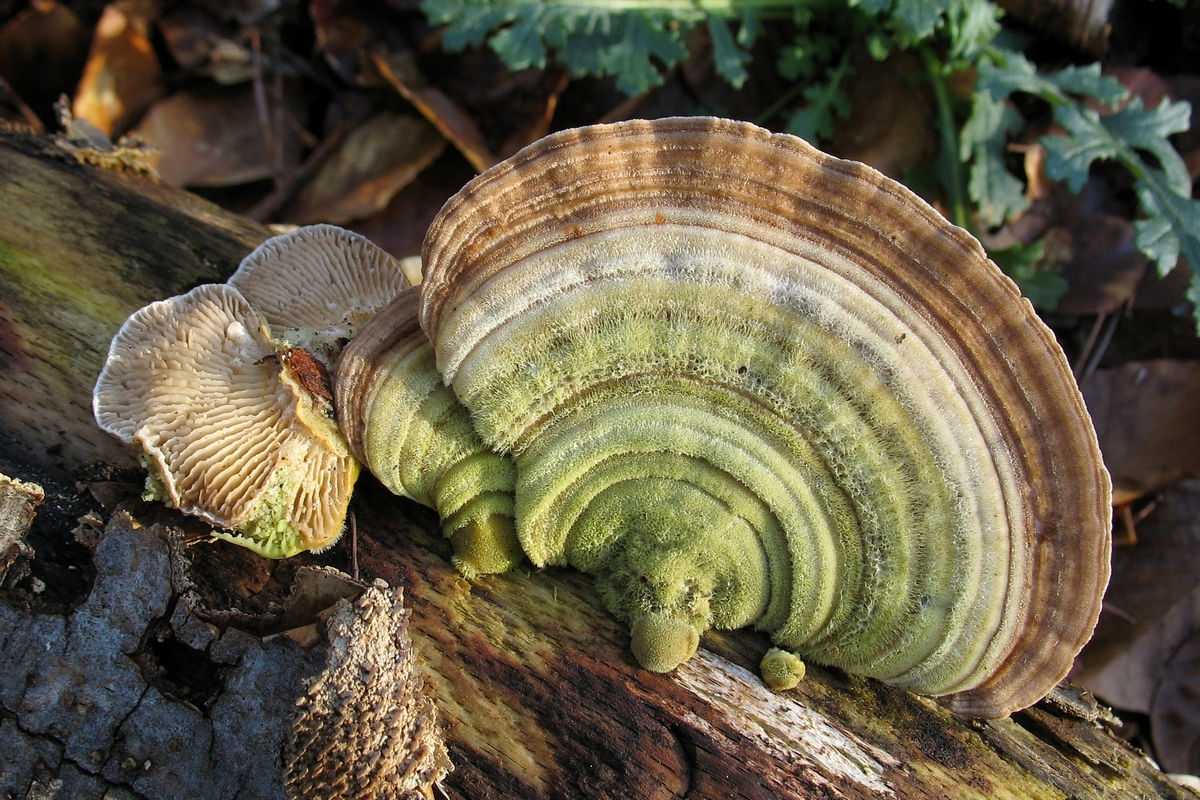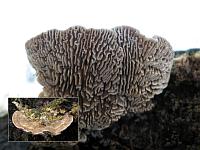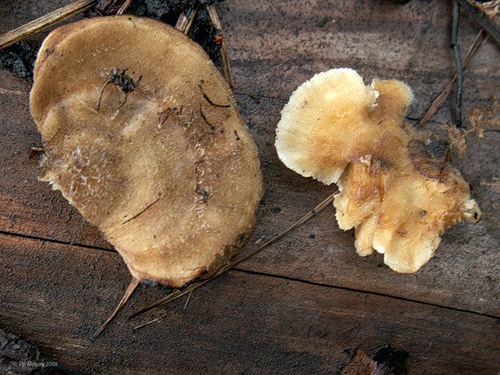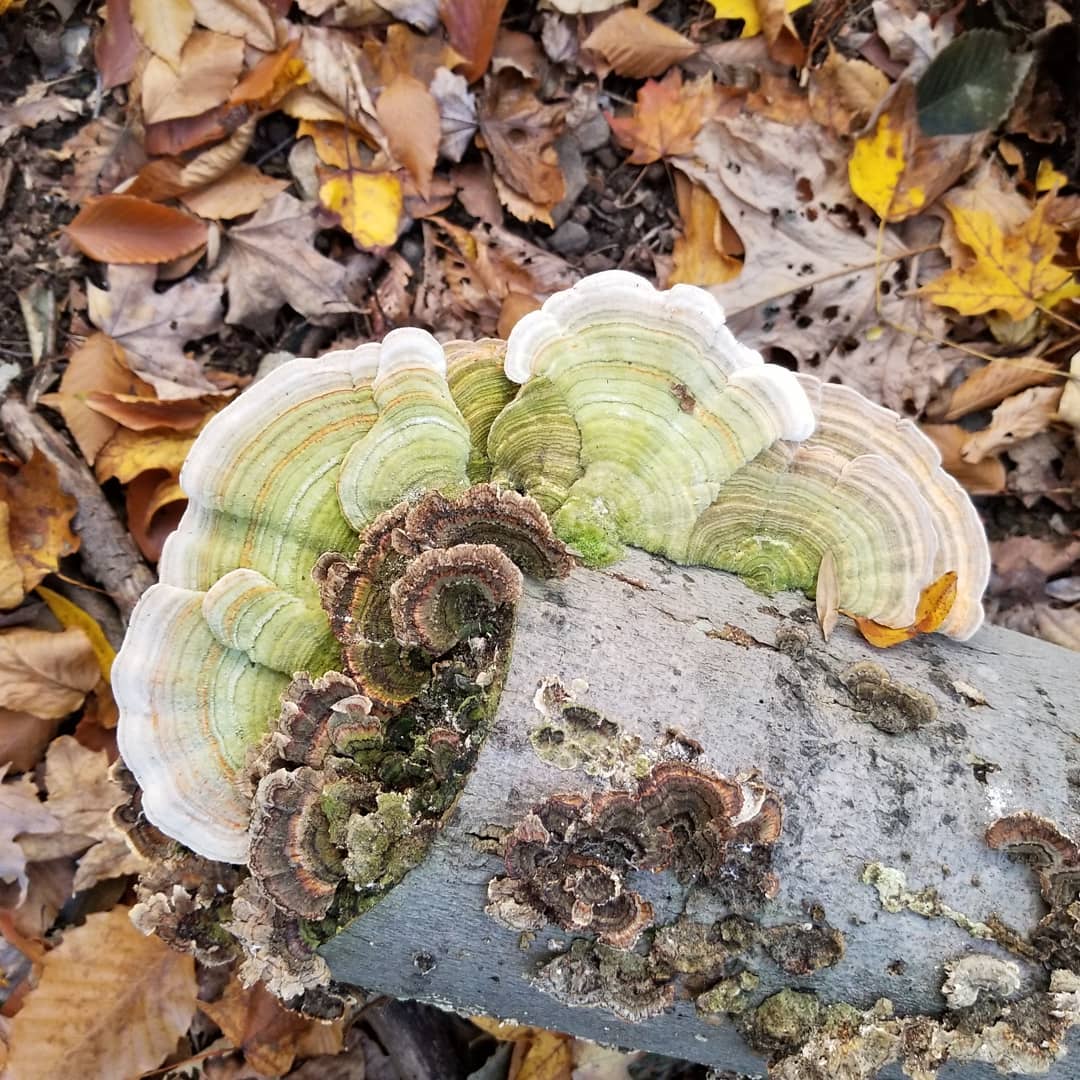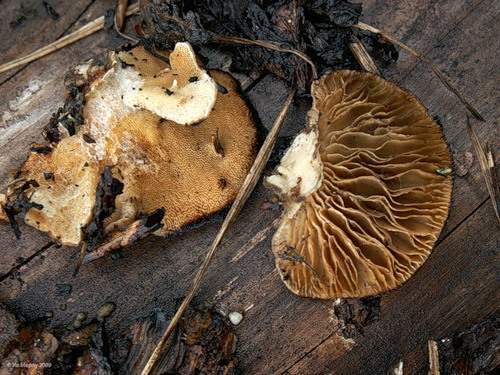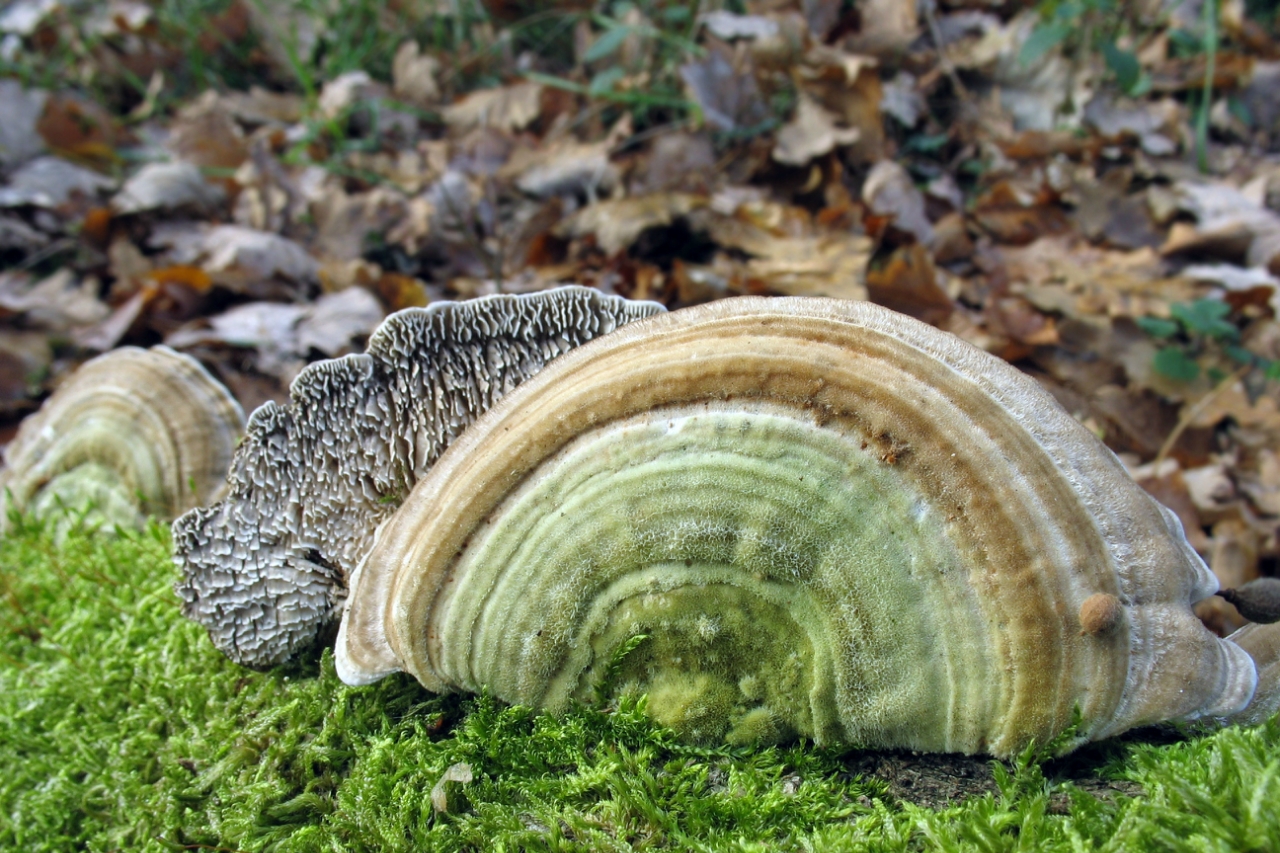Description
Hymenophore
Fruit bodies are annual, in the form of sessile caps, of a hard cork consistency, sometimes completely prostrate. The cap is up to 4 cm wide, its upper surface is coarsely bristly, sometimes with barely expressed concentric zones, creamy beige to ocher beige.
Hymenophore tubular to almost labyrinthine, with thick septa between pores, up to 9 mm thick, dark honey-brownish with age.
The pulp is creamy beige, with a thin (up to 2 mm) underlying strong layer and a thicker (up to 5 mm) fibrous layer; it darkens somewhat upon contact with a KOH solution.
The hyphal system is trimitic, the generative hyphae of the pulp are thin-walled, with buckles, 2–4 µm thick, the skeletal hyphae of the pulp are thick-walled, aseptic, 4–6 µm thick, the connecting pulp hyphae are thick-walled, aseptic, 2–3.5 µm thick. Cystyds are absent. Basidia are tetrasporous, clavate, 18-23 × 6-7.5 µm. Spores are colorless, cylindrical, 7–12 × 2.5–4 µm.
Similar species
Trametes is not the only one of its kind, it has a lot of doubles, and in general, mushrooms similar to it. Let's find out which forest dwellers can be confused with the tinder fungus, which has a variegated cap and hides in the trees.
Harsh trametess
The harsh-haired trameteos is one of those mushrooms that are very similar to the multi-colored tinder fungus. He also owns a very thin, as well as a semicircular gray hat. However, this hat is not so variegated, saturated in colors. As for the upper part, it is not smooth, it is covered with a kind of large cannons.
It has a canonical form. The pulp itself has two layers at once, in the upper part it is somewhat fibrous, and not very pleasant to the touch. And from the bottom it has a cork structure.
Just like its fellows, the stiff-haired tinder fungus settles on deciduous trees, but it is almost impossible to find them on conifers. Most often found in the northern hemisphere.
Fluffy trametes
Fluffy Trametes is another popular mushroom that also repeats its colorful counterpart. It is worth noting that this mushroom is also not edible, which means that it is not suitable for food. However, unlike its brother, it is annual. His hat is very fluffy if you run your hand over it. Fruit bodies are furrowed, reticulate. The color here most often has an olive tint, less often gray.
The pulp has a white tint, which becomes gray with prolonged interaction with oxygen.
Such mushrooms grow most often on rotting stumps, most of all they like to settle on old trees such as birch and linden. It is very rare to be found on representatives of conifers.
Also, these mushrooms can easily take over processed wood. The fruiting bodies of this fungus are very short-lived, they are quickly destroyed when interacting with woody insects.
Taxonomy
Title edit code
Lencites birch was first described by Karl Linnaeus as a composite genus of lamellar mushrooms. In 1838, the famous Swedish mycologist Elias Magnus Fries described a new genus using it Lenzites, naming it after the German mycologist Harald Otmar Lenz.
The scientific name of the mushroom is often written in the feminine gender - betulinaas originally pointed out by Fries. However, according to article 62.4 of the International Code on the Nomenclature of Algae, Fungi and Plants, genera ending with -ites should be accepted as masculine, no matter what they were considered in the first publication. Hence the correct name is Lenzites betulinus.
Synonyms edit code
- Agaricus betulinus L., 1753basionym
- Agaricus coriaceus Bull., 1789, nom. illeg.
- Agaricus flaccidus Bull., 1788
- Agaricus hirsutus Schaeff., 1774, nom. superfl.
- Agaricus tomentosus Lam., 1778
- Agaricus versicolor Planer, 1788, nom. illeg.
- Apus coriaceus (Bull.) Gray, 1821
- Cellularia betulina (L.) Kuntze, 1898
- Cellularia cinnamomea (Fr.) Kuntze, 1898
- Cellularia flaccida (Bull.) Kuntze, 1898
- Cellularia hirsuta (Schaeff.) Kuntze, 1898, nom. superfl.
- Cellularia interrupta (Fr.) Kuntze, 1898
- Cellularia junghuhnii (Lév.) Kuntze, 1898
- Cellularia pinastri (Kalchbr.) Kuntze, 1898
- Cellularia sorbina (P. Karst.) Kuntze, 1898
- Cellularia umbrina (Fr.) Kuntze, 1898
- Daedalea betulina (L.) Rebent., 1804
- Daedalea cinnamomea (Fr.) E.H.L. Krause, 1928
- Daedalea coriacea (Bull.) Pers., 1818
- Daedalea flaccida (Bull.) E.H.L. Krause, 1928
- Daedalea interrupta Fr., 1830
- Daedalea variegata Fr., 1818
- Gloeophyllum cinnamomeum (Fr.) P. Karst., 1882
- Gloeophyllum hirsutum (Schaeff.) Murrill, 1903
- Lenzites berkeleyi Lév., 1846
- Lenzites betuliniformis Murrill, 1908
- Lenzites cinnamomeus Fr., 1851
- Lenzites connatus Lázaro Ibiza, 1916
- Lenzites cyclogrammus Pat., 1907
- Lenzites flaccidus (Bull.) Fr., 1838
- Lenzites flaccidus var. nitens Speg., 1889
- Lenzites hispidus Lázaro Ibiza, 1916
- Lenzites isabellinus Lloyd, 1922
- Lenzites japonicus Berk. & M.A. Curtis, 1858
- Lenzites junghuhnii Lév., 1844
- Lenzites ochraceus Lloyd, 1922
- Lenzites pertenuis Lloyd, 1922
- Lenzites pinastri Kalchbr., 1874
- Lenzites sorbinus P. Karst., 1881
- Lenzites subbetulinus Murrill, 1912
- Lenzites umbrinus Fr., 1838
- Merulius betulinus (L.) Wulfen, 1786
- Merulius squamosus Schrad. ex J. F. Gmel., 1792, nom. superfl.
- Sesia hirsuta (Schaeff.) Murrill, 1903
- Trametes betulina (L.) Pilát, 1939
Medicinal properties of birch lenzites.
Lensites birch is a medicinal mushroom, it has antioxidant, antitumor, antimicrobial, immunosuppressive and antiviral activity. It is recommended for use in HIV patients. The extract of these fungi inhibits the growth of cancer cells of the SMMC-7721 and HeLa lines, and the saccharides, which are part of the birch lensites, stop the development of Ehrlich's carcinoma and sarcoma-180.
Betulinans A and B were isolated from birch lenzites; they are promising for the treatment of many diseases in which free radicals are formed, for example, atherosclerosis, rheumatoid arthritis, diabetes, ischemia, and early tumors. Immunosuppressive drugs based on these fungi strengthen the immune system and prevent the risk of rejection of transplanted tissues, organs and implants.

In Chinese folk medicine, birch lenzites is used to relax muscles that occur during cramps, to treat apoplexy, bone growths, tendon pain, and colds.
Biological Description of Birch Lenzites.
The fruiting body of the birch lensites does not have a leg, it is thin, semi-rosette in shape. Most often, fruiting bodies are located on a fertile substrate in tiers. Hats with a diameter of 2-10 centimeters, their edges are sharp. The upper part of the cap is velvety or felt. Initially, the felt is white, but gradually it darkens, becomes grayish or creamy. Often, the edge becomes covered with multi-colored algae over time.

The fungus hymenophore is lamellar, the plates are located radially. The plates are strongly branched and intertwined with each other. The color of the plates is initially whitish, but later it becomes light cream or yellow-buffy. Fungal spores are colorless, characterized by very thin walls, and their shape is cylindrical.
Effect of birch lensites on wood.
Lensites birch is a parasite, when it settles on a tree, white rot develops. Often, these fungi destroy the foundations of wooden plants. The presence of birch lensites indicates the harmful impact of humans on the environment.

Areas of growth of birch lenzites.
This is an annual mushroom. Most often, this type of mushroom grows in the temperate regions of the Northern Hemisphere. Lenzites is one of the saprotrophs, therefore it is found on dry wood and stumps. Most often, these mushrooms settle in birch deadwood, which is emphasized by the name, but they also grow on other types of trees.
Evaluation of the edibility of birch lenzites.
There are no toxic substances in the composition of this mushroom, in addition, the taste of the mushroom pulp cannot be called unpleasant, but the fruiting bodies are very tough, therefore birch lensites is classified as an inedible variety.

This mushroom is not used for culinary purposes. But from the powder of dried fruit bodies, you can make healing tea. To do this, boil 2-3 fruiting bodies for about 45 minutes in 0.5 liters of water, and drink it in a cup 2-3 times a day. This tea can be consumed with sugar.
Similar species.
When viewed from the top of the birch lensites, it is very similar to the multicolored trametess and the coarse-haired trametus. However, these species can be easily distinguished by the lamellar hymenophore - the color of the birch lenzites is darker.

Lensites birch is also externally similar to its brother - Lenzites Warnier, which grows in the Krasnodar Territory, Siberia and the Far East. Lenzites Warnier can be recognized by the greater thickness of the fruiting body and plates.
External resemblance is also observed with Lenzites acute, inhabiting the Far East.The fruit bodies of this mushroom are dark, and the flesh is creamy.

